Options for Evaluating Environmental Cleaning
Appendices to the Conceptual Program Model for Environmental Evaluation
Appendix A
Elements of the Educational Intervention
Environmental Services Line Personnel – A presentation should be developed for all line staff involved in terminal room cleaning and should:
- Provide an overview of the importance of HAIs in a manner commensurate with their educational level using as many pictorial illustrations as is feasible.
- Explain their role in improving patient safety through optimized hygienic practice.
- Review specific terminal room cleaning practice expectations.
- Discuss the manner in which their practice will be evaluated. For Level II programs, a participatory demonstration of the monitoring method is very useful.
- Provide them with information from the baseline evaluation emphasizing or possibly exclusively showing them results for those objects which have been most thoroughly cleaned (Level II).
- Stress the non-punitive nature of the program.
- Inform them that their good performance will be broadly recognized (i.e., beyond their department) and highlighted within their department for others to emulate. (Level II)
- Repeatedly reinforce the importance of their work, and how it directly relates to the hospital’s goals and mission and how it is appreciated by patients and plays a major role in a patient’s satisfaction with the hospital.
Many hospitals have provided a small (possibly ES staff-language specific) pictorial booklet to the environmental services personnel at the conclusion of the presentation which is often developed to be language skill appropriate.
ES managers – As senior managers will be actively involved in the design and implementation of either Level I or Level II programs, educational interventions for them will need to be customized. While many of these individuals have an excellent understanding of the basic policies and procedures involved in terminal room cleaning, most will benefit from focused educational interventions related to our evolving understanding of the role of the environment in healthcare-associated pathogen (HAP) transmission. Evaluation of mid-level managers also needs to be customized. Most importantly, the impact of the program on mid-level ES managers needs to be monitored since additional formal and informal education is frequently needed for those individuals who are somewhat unsure of the importance of developing programmatic approaches to optimize terminal room cleaning.
Other groups – Given the overall importance of optimizing the thoroughness of hygienic practice in healthcare settings, hospital specific educational interventions graphically illustrating the impact of the program should be considered for both Level I and Level II programs. Such communications should be developed for a range of audiences within the hospital including the senior hospital administration, the medical staff, nursing personnel on the units, executive nursing and medical staff committees and the hospital’s board of managers or directors.
Appendix B
Objective Methods for Evaluating Environmental Hygiene
In considering implementation of a Level II program, the advantages and limitations of various monitoring approaches must be considered carefully. The factors which distinguish each approach to Level II monitoring are discussed below and summarized in Fig.1. With any method or methods used it is important that neither the system itself (fluorescent marker) nor its use (precleaning cultures or ATP measurements) induce a Hawthorne type effect.
Direct Practice Observation – Covert monitoring of disinfection cleaning can provide an objective assessment of individual ES staff performance and compliance with cleaning protocols. This approach has been used to objectively evaluate and improve ICU environmental hygiene in one hospital.[1] While conceptually feasible, logistical issues related to maintaining such a program outside a research setting may limit adaptation of this form of Level II monitoring. Furthermore, the complexity of monitoring cleaning practice in individual patient rooms without the evaluator being recognized as such might represent a difficult confounding issue.
Swab Cultures – While several outbreak intervention studies have associated decreased environmental contamination by target organisms as a result of modified cleaning practice leading to decreased acquisition of targeted pathogens, none of the reports specifically note if serial environmental culture results were actually used to provide practice feedback to the ES staff. Although swab cultures are easy to use, the cost of processing, including isolate identification, the delay in analyzing results, the need to determine pre-cleaning levels of contamination for each object evaluated in order to accurately assess cleaning practice, and the limited feasibility of monitoring multiple surfaces in multiple patient rooms as part of an ongoing Level II monitoring program represent issues which could limit the broad application of this system.
Agar Slide Cultures – Agar coated glass slides with finger holds were developed to simplify quantitative cultures of liquids. The slides have been adopted for use in environmental surface monitoring in healthcare settings.[2] These studies have used agar coated slide systems to evaluate cleaning practice by quantifying aerobic colony counts (ACCs) per cm.[2,3] While studies have measured aggregate ACCs before and after cleaning, no studies to date have evaluated the actual thoroughness of cleaning of the same objects to determine if objects with relatively high ACCs were either poorly cleaned or actually overlooked by the ES staff. Although some difficulties have been encountered in utilizing the agar slide cultures on other than large, flat surfaces, they potentially provide an easy method for quantifying viable microbial surface contamination. There is a need, similar to that noted above for swab cultures, to determine pre-cleaning levels of contamination for each object evaluated in order to accurately assess cleaning practice.
Fluorescent Markers – Fluorescent gel, powder, and lotion have all been developed for the purpose of marking high touch objects prior to room cleaning. While the powder and lotion have been used as part of educational interventions, their overt visibility (lotions and powder), ease with which they can be disturbed (powder), and difficulty with easy removal (lotion if allowed to air dry) may limit their use in a monitoring system and there is little or no published experience in their use for this purpose. In contrast, the fluorescent gel dries transparent on surfaces, resists abrasion, and there are several studies demonstrating the accuracy of the system in objectively evaluating cleaning practice and quantifying the impact of educational interventions on such cleaning.[4,5] Because these fluorescent markers are all designed to indicate physical removal of an applied substance, surfaces that are effectively disinfected but less effectively cleaned may be more likely flagged as failing to meet a quality standard using one of these markers than one of the culture techniques.
ATP Bioluminesence – The measurement of organic ATP on surfaces using a luciferase assay and luminometer has been used to evaluate cleanliness of food preparation surfaces for more than thirty years. A specialized swab is used to sample a standardized surface area which is then analyzed using a portable handheld luminometer. The total amount of ATP, both microbial and non-microbial, is quantified and expressed as relative light units. Although readout scales vary more than 10 fold and sensitivity varies between commercially available systems, very low readings are typically associated with low aerobic colony counts (ACCs).[6] Very high readings may represent either a viable bioburden, organic debris including dead bacteria or a combination of both. An independent study in 2007 by the U.K. National Health Service evaluating the potential role of the ATP tool in assessing cleaning practice concluded that the tool could potentially be used effectively for ES education.[7] Although it is likely that part of the lack of correlation between ATP readings and ACCs noted in the preceding studies relates to the fact that ATP systems measure organic debris as well as viable bacterial counts, several studies have noted additional environmental factors which may increase or decrease ATP readings. Because a large proportion of surface contamination with ATP is non-microbial in origin, surfaces that are effectively disinfected but less effectively cleaned may be more likely flagged as failing to meet a quality standard using the ATP tool than one of the culture techniques. Additionally, high concentrations of bleach may potentially quench the ATP bioluminescence reaction and result in a signal reduction, but further research is needed to better understand the impact of bleach-based disinfectants on the use of the ATP system. If a bleach-based disinfectant is used, it is important that the surface is dry before using the ATP tool. Similar to the culture methods described above, it is unclear whether “threshold values” for a clean hospital surface can be established using existing methods, suggesting use of the ATP tool is likely to require pre-cleaning levels of contamination for each object evaluated in order to accurately assess cleaning practice. Despite these limitations, the ATP system has been used to broadly document significant improvement in daily cleaning as well as provide quantitative measurement to indicate the level of cleanliness of high touch surfaces.[8,9]
Final Points
No matter which of the Level II monitoring approaches is chosen by the hospital, it is important that the monitoring be performed by hospital epidemiologists, infection preventionists or their designees who are not part of the actual ES cleaning program. Such an approach assures the validity of the information collected and provides an opportunity for the Infection Control and Prevention Department to independently champion the value of well performed disinfection cleaning.
A more detailed and fully referenced discussion of the above noted approaches to Level II monitoring of terminal room cleaning, may be found in the article Evaluating Hygienic Cleaning in Healthcare Settings: What You Don’t Know Can Harm Your Patientsexternal icon by P.C. Carling and J.M. Bartley in the June, 2010 supplement to the American Journal of Infection Control
Appendix C
Sample Size Determination
Logistical issues must also be considered as part of planning for the implementation of an enhanced program. Before a decision has been made to use one of the Level II methods to objectively monitor cleaning practice, it is important to determine the number of surfaces to be evaluated for establishing baseline level of thoroughness of cleaning and the number of data points which must be monitored on a regular basis to accurately assess improvement or deterioration in practice. While it would be ideal to be able to identify small fluctuations in practice accurately (e.g., 10% relative change), such an approach would be highly labor intensive. Instead, a meaningful change in cleaning practice (e.g., 20% relative change) can be detected without having to evaluate a substantial number of surfaces. Previous experience suggests that conducting a baseline evaluation of all available surfaces (listed in the checklist) in a 10-15% sample of representative patient rooms is reasonable in a hospital with ≥150 beds. When hospitals have achieved a thoroughness of cleaning rate of >80%, the number of surfaces to be monitored can be decreased to those available in a 5% sample of rooms per evaluation cycle unless there is a deterioration in practice. In hospitals with less than 150 beds, all available surfaces (listed in the checklist) in a minimum of 15 rooms may be monitored for baseline and ongoing evaluation.
Appendix D
Calculation of Aggregate Thoroughness of Disinfection Cleaning (TDC) Score
The results of the evaluation of each object listed on the check list can be recorded in the attached excel spreadsheet template. The percentage of individual surfaces cleaned across multiple patient rooms will be automatically calculated by the excel spreadsheet. Because it has been found that cleaning practice within an institution is more likely to vary between types of objects than by patient units, the high touch surfaces listed in the check list have been grouped into 5 categories for calculating aggregate TDC scores: High Touch I, High Touch II, High Touch III, Bathroom Surfaces, and Equipment Surfaces. The aggregate TDC scores for each category of objects can be reported to the HAI prevention collaborative coordinator by various mechanisms (e.g., NHSN), depending on infrastructure.
References:
- Hayden MK, Bonten MJ, Blom DW, Lyle EA. Reduction in acquisition of vancomycin-resistant enterococcus after enforcement of routine environmental cleaning measures. Clin Infect Disease 2006;42:11,1552-60.
- Dancer SJ, White LF, Lamb J, Girvan EK, Robertson C. Measuring the effect of enhanced cleaning in a UK hospital: a prospective cross-over study. BMC Med 2009;June8:7-28.
- Griffith CJ, Cooper RA, Gilmore J, Davies C, Lewis M. An evaluation of hospital cleaning regimes and standards. J Hosp Infect 2000;45:19-28.
- Carling PC, Parry MM, Rupp ME, Po JL, Dick BL, Von Beheren S. for the Healthcare Environmental Hygiene Study Group. Improving cleaning of the environment surrounding patients in 36 acute care hospitals. Inf Control Hosp Epidem 2008; 29:11,1035-1041.
- Goodman ER, Platt R, Bass R, Onderdonk AB, Yokoe DS, Huang SS. Impact of an environmental cleaning intervention on the presence of methicillin-resistant Staphylococcus aureus and vancomycin-resistant enterococci on surfaces in intensive care unit rooms. Infect Control Hosp Epi Demiol 2008; 29:593-599.
- Aycicek H, Oguz U, Karci K. Comparison of results of ATP bioluminescence and traditional hygiene swabbing methods for the determination of surface cleanliness at a hospital kitchen. Int J Hyg Environ Health 2006;209:203-6.
- Willis C, Morley J,Westbury J, Greenwood M, Pallett A. Evaluation of ATP bioluminescence swabbing as a monitoring and training tool for effective hospital cleaning. Br J of Infect Control 2007 8:17-21.
- Boyce JM, Havill NL, Dumigan DG, Golebiewski M, Balogun O, Rizvani R. Monitoring the effectiveness of hospital cleaning practices by use of an adenosine triphosphate bioluminescence assay. Infect Control Hosp Epidemiol 2009;30,7:678-84.
- Boyce JM, Havill NL, Lipka A, Havill H, Rizvani R. Variations in hospital daily cleaning practices. Infect Control Hosp Epidemiol 2010;31,1:99-101.
Figure 1
| Method | Ease of Use | Identifies Pathogens | Useful for Individual Teaching | Directly Evaluates Cleaning | Published Use in Programmatic Improvement |
|---|---|---|---|---|---|
| Direct Practice Observation | Low | No | Yes | Yes | 1 Hospital |
| Swab cultures | High | Yes | Not Studied | Potentially | 1 Hospital |
| Agar slide cultures | Good | Limited | Not Studied | Potentially | 1 Hospital |
| Fluorescent gel | High | No | Yes | Yes | 49 Hospitals |
| ATP system | High | No | Yes | Potentially | 2 Hospitals |
Instructions for Evaluating the Cleaning of Objects in the Patient Zone
The group of objects on the checklist was chosen on the basis of information regarding the contamination of these surfaces with healthcare-associated pathogens (HAPs) as well as a consideration of the likelihood they would be touched during routine care by healthcare personnel without changing gloves or performing hand hygiene prior to using these items.
The following descriptions and suggestions should be used to standardize, to the degree feasible, the manner in which the thoroughness of cleaning can be most consistently evaluated. If the evaluation system utilizes a fluorescent gel targeting system, the targets should generally be placed very near but not in/on the area of the object touched in routine use (as noted in the outline below) in order to avoid disturbing the target during actual use of the object. If one of the direct evaluation systems (one of the two culture methods or the ATP method as described in the Appendix) is being used, the primary hand touch area of each object should be evaluated as noted in the outline below, taking particular care to evaluate exactly the same area of the object before and after cleaning.
All available objects noted below should be marked in each room
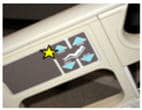
Bed Control

Phone and Call Button
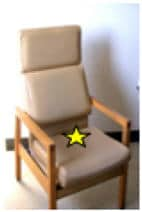
Chair
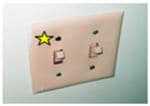
Light Switch
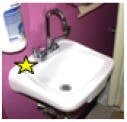
Sink Top
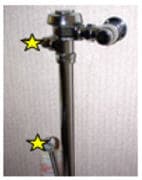
Flush Handle
Patient Area
- Bed rails – If the bed rail incorporates bed controls, evaluate the control area (on the patient side) slightly away from the control buttons. If the rails do not contain the new style control areas, the rails are best evaluated on the smooth inner surface in an area easily accessible to cleaning.
- Tray table – The top of the tray table should be evaluated in one corner.
- Call boxes – Evaluation is done on the back mid portion of the call box in an area easily accessible to cleaning. If tiny call buttons are used, mark the separate TV control box instead if feasible.
- Telephones – Evaluation is best done on the back side of the hand-held portion of the telephone near the top of the phone, away from the end that is attached to the phone wire.
- Bedside tables – The drawer pull is evaluated.
- Patient chair – Evaluation is done in the center of the seat of the chair close to the rear of the cushion. If the cushion is covered in textured fabric, evaluate the arm of the chair.
- IV pole – For hanging IV poles, the shaft of the pole just above the textured grab area should be evaluated. For standing IV poles, the chest-high portion where hand contact is most common should be evaluated.
Toilet Area
- Sinks – If using a targeting system, the best place to mark the sink rim is towards the rear in order to avoid water splash interference with evaluation of the target. If direct evaluation is used, the faucet handle should be evaluated.
- Bathroom and patient room light switches – When using a targeting method, a target is placed on the plate portion of the light switch. When using a direct evaluation system, the switch or plate should be evaluated because of its relatively large surface area.
- Door knobs and door levers – The inside door knob or lever is marked for each bathroom door and each patient room door. If using a targeting system on a round door knob, the mark is best placed as close to the middle of the face of the door knob as possible. If the knob has a locking mechanism, place the target on the circular door plate that surrounds the handle. Lever-type handles are marked on any easily cleanable surface somewhat away from the end of the lever where direct hand contact would be most frequent. Similarly, when using a fluorescent system, door push plates are marked in the middle of the smooth part of the plate. When using direct evaluation systems, the most frequently contacted portion of the door knob, lever or push plate should be evaluated.
- Toilet area hand holds (bathroom handrails) – Evaluate the most accessible surface of the hand hold just off the edge of the textured surface at the curve where the hand hold goes towards the wall. If there are two hand holds, mark the one most likely to be touched by a patient using the toilet.
- Toilet seats –When using a targeting method, the target is placed on the back of the toilet seat just below the outside edge of the seat in an area readily accessible to cleaning activities. When using a direct evaluation method, the surface of the toilet seat should be evaluated, being sure to evaluate the same area before and after cleaning.
- Toilet handles – When using a targeting method, the target is placed on top of the handle approximately two thirds away from the end of the handle.
- Bed pan cleaning equipment – Two types of bed pan cleaning equipment designed as part of toilet units are in general use in hospitals.
- Hinged pipe type cleaner – The most commonly used bed pan cleaner consists of a pipe with a small shower head type device that is lowered over the toilet bowl by the user. When the arm is lowered, the toilet flush water is sprayed in a stream through the cleaner head. This device is best targeted by marking the spray head (the most common area which would be touched by users).
- Spray hoses – Some toilets have a spray hose with a lever-type trigger on the handle which is depressed to activate the spray head. Evaluate the handle itself.
Where Applicable
- IV Pump control panel –Evaluate an area that is just adjacent to the portion of the panel that is most frequently touched by healthcare providers.
- Monitor control panel – When using a targeting method, the control panel should be evaluated in an area immediately adjacent to a part of the panel which is directly contacted by caregivers’ hands. When using a direct method, the control area itself is evaluated.
- Monitor touch screen – The touch screen should be evaluated in the lower right hand corner in an area easily accessible to cleaning.
- Monitor cables – Evaluate the junction box area.
- Ventilator control panel – Evaluate an area immediately adjacent to a part of the panel which is
Word count: 3324
Last edited by Randy on May 16, 2019 at 9:18 am
Toggle panel: Save
?
File Name *
appendices-evaluating-environ-cleaning.html
Save Preview
Last Saved: May 16, 2019 @ 9:18am by Randy
Toggle panel: Publish to Dev
Publish
Status:Queued
Last Published:May 10, 2019 @ 4:11pm by Randy (hiv8)
Do Not Publish
Toggle panel: Publish to Link
Request Publish View
Status:Edits Not Published
Last Published:Apr 11, 2017 @ 12:37pm by Jesse Tucker (iem2)
Request Unpublish
Toggle panel: Syndicate
Status: Not Syndicated
Date:
Syndicate Now
Toggle panel: Content Analysis
Check Links Validate Page Metrics Relationships Audit Log Diagnostics See Revisions SSIs
Toggle panel: Notes
?
Internal-Only Description
?
Internal Notes
Toggle panel: Sitemap Options
Exclude from Sitemap
Priority
Change Frequency
Toggle panel: Basic Options
?
Page Type *
Content Home
?
Page Template *
With left nav Without left nav
Article Date
?
Short Title
Appendices to the Conceptual Program Model for Environmental Evaluation
?
Browser Title
?
Subtitle
Section Nav Heading (Override)
?
Link Descriptor Text
VisualText
File Edit View Insert Format Tools Table
Paragraph
?
Iconic Image
Select Item….
Select
?
Language *
?
Last Reviewed *
10/15/2010
?
Last Reviewed Time
?
Last Updated *
05/16/2019
?
Last Updated Time
Toggle panel: Display Options
Show Persistent Content Area on Mobile
?
Show Expand/Collapse Options (Top of page)
?
Multi-Page Module
Select Item….
Select
?
Visual Element
Select Item….
Select
?
Under Left Nav
Select Item….
Select
?
Persistent Content Area
Select Item….
Select
Display Article Date on Page
Show Categories/Taxonomy Terms on Page
Sort/Filter Page
Select Item….
Select
Toggle panel: Related Content
Toggle panel: Slug
Toggle panel: Multichannel Options
Toggle panel: Social Media
Toggle panel: Metatags and Taxonomies
Toggle panel: Advanced Options
Toggle panel: Revisions
Randy, 1 min ago (May 16, 2019 @ 09:18:55)
Randy, 1 min ago (May 16, 2019 @ 09:18:26)
Randy, 1 min ago (May 16, 2019 @ 09:17:48) [Autosave]
Randy, 3 weeks ago (April 22, 2019 @ 15:14:52)
cdc_wp, 4 weeks ago (April 16, 2019 @ 15:16:28)
ryp9, 2 years ago (April 10, 2017 @ 11:55:45)
ryp9, 2 years ago (April 10, 2017 @ 11:55:43) [Autosave]
ryp9, 2 years ago (April 10, 2017 @ 11:51:45)
, 2 years ago (April 7, 2017 @ 11:11:16)
, 2 years ago (April 7, 2017 @ 11:11:16)
, 2 years ago (April 7, 2017 @ 11:11:15)
Thank you for creating with WordPress. WP Version: Version 4.9.10 / WCMS Build: 4.8.4 – b.1899 / Srv: 158.111.179.215, Site ID: 491 / Release Notes